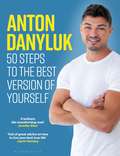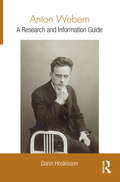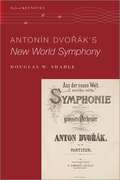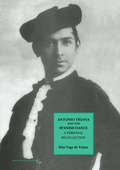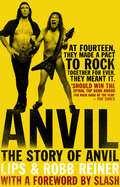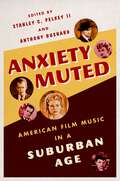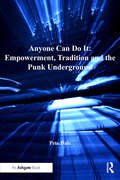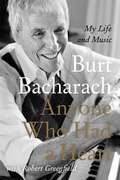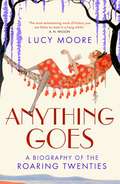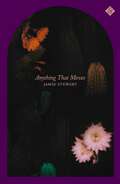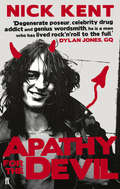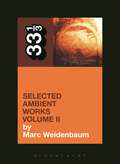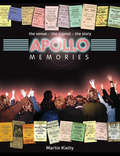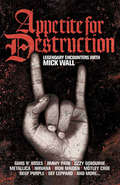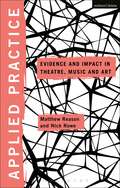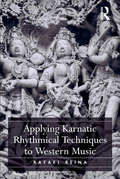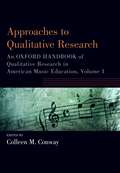- Table View
- List View
Anton Danyluk: 50 Steps to the Best Version of Yourself
by Anton Danyluk'A brilliant, life-transforming read' – Jennifer West'Full of great advice on how to live your best true life' – Jaymi HensleyAnton Danyluk has been on an incredible journey, from awkward, overweight teenager to World Merit ambassador, Love Island favourite, Instagram star and respected fitness trainer. Having overcome his own personal challenges, Anton sets out the simple steps you can take to feel good about yourself every day. Anton is on a mission to encourage others who are struggling with their wellbeing and fitness, and wants to help everyone live healthy and happy lifestyles – and if Anton can do it, so can you. Open and honest, engaging and relatable, this part-practical, part-autobiographical book will motivate and empower you on the journey towards your best self.- Develop a strong sense of who you really are- Embrace opportunity – and you'll never fear failure again- Make exercise your medicine – you won't believe how good you can feel- Get the body you want – without going to extremesAnton's level-headed and achievable advice has everything you need to feel good, look great and live the best version of yourself.
Anton Webern: A Research and Information Guide (Routledge Music Bibliographies)
by Darin HoskissonAnton Webern: A Research and Information Guide offers carefully selected and annotated sources regarding Webern from 1975 to present day, including sources on Webern’s life, his music, and the interpretation and reception of his music. Along with this comprehensive annotated listing of print and online sources, the book discusses the history of research on Webern and includes a brief chronology of his life. It is a major reference tool for those interested in Webern and his music and valuable for researchers of 20th century music and the Second Viennese School.
Anton Webern: A Research and Information Guide (Routledge Music Bibliographies)
by Darin HoskissonAnton Webern: A Research and Information Guide offers carefully selected and annotated sources regarding Webern from 1975 to present day, including sources on Webern’s life, his music, and the interpretation and reception of his music. Along with this comprehensive annotated listing of print and online sources, the book discusses the history of research on Webern and includes a brief chronology of his life. It is a major reference tool for those interested in Webern and his music and valuable for researchers of 20th century music and the Second Viennese School.
Antonín Dvo%rák's New World Symphony (Oxford Keynotes)
by Douglas W. ShadleBefore Antonín Dvorák's New World Symphony became one of the most universally beloved pieces of classical music, it exposed the deep wounds of racism at the dawn of the Jim Crow era while serving as a flashpoint in broader debates about the American ideals of freedom and equality. Drawing from a diverse array of historical voices, author Douglas W. Shadle's richly textured account of the symphony's 1893 premiere shows that even the classical concert hall could not remain insulated from the country's racial politics.
Antonín Dvo%rák's New World Symphony (Oxford Keynotes)
by Douglas W. ShadleBefore Antonín Dvorák's New World Symphony became one of the most universally beloved pieces of classical music, it exposed the deep wounds of racism at the dawn of the Jim Crow era while serving as a flashpoint in broader debates about the American ideals of freedom and equality. Drawing from a diverse array of historical voices, author Douglas W. Shadle's richly textured account of the symphony's 1893 premiere shows that even the classical concert hall could not remain insulated from the country's racial politics.
Antonio Triana and the Spanish Dance: A Personal Recollection (Choreography and Dance Studies Series)
by Rita Vega de TrianaThis book also traces the evolution of the Spanish Dance technique, marked as it is by a turbulent history. Antonio Triana was a dancer of mature artistry, dignity and power. His physical and technical achievements went beyond what is generally known about Spanish Dance. His dance presented the essence of the Spanish character and, in his choreography, he used his traditional background for his brilliant inspirations. He partnered the legendary La Argentinita, Pilar Lopez and Carmen Amaya with spirit and gallantry. Over the years he developed a very distinct method of teaching and he became one of the foremost Spanish Flamenco dancers and teachers of his time. Rita Vega de Triana formed the Triana Ballet Español with her late husband. She currently teaches Hispanic dance and related subjects at the University of Texas at El Paso and directs her own school as well as performing around the United States as a guest artist and choreographer.
Antonio Triana and the Spanish Dance: A Personal Recollection (Choreography and Dance Studies Series #Vol. 6)
by Rita Vega de TrianaThis book also traces the evolution of the Spanish Dance technique, marked as it is by a turbulent history. Antonio Triana was a dancer of mature artistry, dignity and power. His physical and technical achievements went beyond what is generally known about Spanish Dance. His dance presented the essence of the Spanish character and, in his choreography, he used his traditional background for his brilliant inspirations. He partnered the legendary La Argentinita, Pilar Lopez and Carmen Amaya with spirit and gallantry. Over the years he developed a very distinct method of teaching and he became one of the foremost Spanish Flamenco dancers and teachers of his time. Rita Vega de Triana formed the Triana Ballet Español with her late husband. She currently teaches Hispanic dance and related subjects at the University of Texas at El Paso and directs her own school as well as performing around the United States as a guest artist and choreographer.
Anvil: The Story of Anvil
by Robb Reiner Steve 'Lips' KudlowAt fourteen, Toronto school friends Steve 'Lips' Kudlow and Robb Reiner made a pact to rock together forever. Forming their band 'Anvil' they went on to become the 'demi-gods of Canadian metal', releasing one of the heaviest albums in metal history, 1982's Metal on Metal. The album influenced a musical generation including the world-dominating bands Metallica, Slayer and Anthrax, all of whom went on to sell millions of records. Anvil's career would take a different path, however, as they slipped straight into obscurity...Almost thirty years later Lips and Robb, our unlikely musical heroes, are still chasing their dream. Anvil! The Story of Anvil, their autobiography, follows the ups and down of their career and their volatile friendship (which has now spanned almost four decades), reveals their dedication and unadulterated passion for their music, and carries us along on their last-ditch quest for fame and fortune. Based on Sacha Gervasi's award-winning film of the same name, and published to coincide with its worldwide release, this hilarious yet poignant book reminds us that if you believe in yourself, stick by your friends and never give up, you really can make your dreams come true. You cannot fail to be moved by this story. Anvil rock!
Anxiety Muted: American Film Music in a Suburban Age
by Stanley C. Pelkey Anthony BushardThe most familiar entertainment icons and storylines from the 1950s and 60s remain potent signs that continue to resonate within contemporary American society and culture. Both the political Left and Right invoke the events and memories of those decades, celebrating or condemning the competing social forces embodied in and unleashed during those years. In recent decades, the entertainment industry has capitalized on this trend with films and television shows that take a look back on the 1950s and 1960s with a mixture of nostalgia and criticism. Anxiety Muted: American Film Music in a Suburban Age explores how the central concerns of the Fifties and Sixties--and resulting treatment in the motion picture media--can be examined and understood through the music of the time period. With its focus on soundtrack and scoring, the book demonstrates that specific television shows and films offer a more nuanced vision of community and conformity than is usually recognized, revealing much about our own current social anxieties.
Anyone Can Do It: Empowerment, Tradition and the Punk Underground (Ashgate Popular and Folk Music Series)
by Pete DaleFor more than three decades, a punk underground has repeatedly insisted that 'anyone can do it'. This underground punk movement has evolved via several micro-traditions, each offering distinct and novel presentations of what punk is, isn't, or should be. Underlying all these punk micro-traditions is a politics of empowerment that claims to be anarchistic in character, in the sense that it is contingent upon a spontaneous will to liberty (anyone can do it - in theory). How valid, though, is punk's faith in anarchistic empowerment? Exploring theories from Derrida and Marx, Anyone Can Do It: Empowerment, Tradition and the Punk Underground examines the cultural history and politics of punk. In its political resistance, punk bears an ideological relationship to the folk movement, but punk's faith in novelty and spontaneous liberty distinguish it from folk: where punk's traditions, from the 1970s onwards, have tended to search for an anarchistic 'new-sense', folk singers have more often been socialist/Marxist traditionalists, especially during the 1950s and 60s. Detailed case studies show the continuities and differences between four micro-traditions of punk: anarcho-punk, cutie/'C86', riot grrrl and math rock, thus surveying UK and US punk-related scenes of the 1980s, 1990s and beyond.
Anyone Can Do It: Empowerment, Tradition and the Punk Underground (Ashgate Popular and Folk Music Series)
by Pete DaleFor more than three decades, a punk underground has repeatedly insisted that 'anyone can do it'. This underground punk movement has evolved via several micro-traditions, each offering distinct and novel presentations of what punk is, isn't, or should be. Underlying all these punk micro-traditions is a politics of empowerment that claims to be anarchistic in character, in the sense that it is contingent upon a spontaneous will to liberty (anyone can do it - in theory). How valid, though, is punk's faith in anarchistic empowerment? Exploring theories from Derrida and Marx, Anyone Can Do It: Empowerment, Tradition and the Punk Underground examines the cultural history and politics of punk. In its political resistance, punk bears an ideological relationship to the folk movement, but punk's faith in novelty and spontaneous liberty distinguish it from folk: where punk's traditions, from the 1970s onwards, have tended to search for an anarchistic 'new-sense', folk singers have more often been socialist/Marxist traditionalists, especially during the 1950s and 60s. Detailed case studies show the continuities and differences between four micro-traditions of punk: anarcho-punk, cutie/'C86', riot grrrl and math rock, thus surveying UK and US punk-related scenes of the 1980s, 1990s and beyond.
Anyone Who Had a Heart: My Life and Music
by Burt BacharachBurt Bacharach is one of the most celebrated and legendary song-writers of the twentieth century. Throughout his sixty year career he has worked with artists from Dionne Warwick to Dr Dre, Marlene Dietrich to Elvis Costello.Anyone Who Had a Heart is the story of one of the greatest song writers of all time. It traces for the first time in his own words, the life and times of the man who created the music that has become the sound track for the lives of his millions of devoted fans all over the world.Bacharach's songs include: 'Magic Moments' - Perry Como, ' Baby It's You' - The Shirelles / The Beatles, 'Please Stay' - The Drifters / Marc Almond, 'Wishin' and Hopin'' - Dionne Warwick / Dusty Springfield / Ani DiFranco, 'Walk On By' - Dionne Warwick / The Stranglers, 'I Just Don't Know What to Do with Myself' - Dusty Springfield / The White Stripes, '(There's) Always Something There to Remind Me' - Sandie Shaw, 'A Message to Martha' - Adam Faith, 'What's New Pussycat?' - Tom Jones, 'Trains and Boats and Planes' - Billy J. Kramer & the Dakotas, 'Alfie' - Cilla Black / Cher / Rumer, 'I Say a Little Prayer' - Dionne Warwick / Aretha Franklin, 'Do You Know the Way to San Jose?' - Dionne Warwick, 'Raindrops Keep Fallin' on My Head' - B.J. Thomas / Sacha Distel / Johnny Mathis, 'I'll Never Fall in Love Again' - Bobby Gentry, 'Arthur's Theme (Best That You Can Do)' - Burt Bacharach / Barry Manilow / Shirley Bassey.
Anything Goes: A Biography of the Roaring Twenties
by Lucy MooreBracketed by the catastrophes of the Great War and the Wall Street Crash, 1920s America was a place of drama, tension and hedonism. It glittered and seduced: jazz, flappers, wild all-night parties, the birth of Hollywood, and a glamorous gangster-led crime scene flourishing under prohibition. But the period was also punctuated by momentous events - the political show trials of Sacco and Vanzetti; the huge Ku Klux Klan march down Washington DC's Pennsylvania Avenue - and it produced a splendid array of writers, musicians and film stars, from F. Scott Fitzgerald to Bessie Smith and Charlie Chaplin.
Anything That Moves
by Jamie StewartFrom being caught having their first orgasm by their mum’s best friend to being stalked and propositioned by a fundamentalist pastor; from soliciting spanking dates over the Internet to scoring a coveted invitation to a threesome with some elf fetishist neighbours, art rock darling (Xiu Xiu) Jamie Stewart’s journey of fleshy self-discovery and queer awakening makes for an extraordinary, cringy, unputdownable epic in miniature, burning always with radical and often shocking self-criticism.A one-of-a-kind exploration of abasement, depravity, joy, and embarrassment (and even joy in embarrassment), Anything That Moves is a series of comic, tragic X-rays of sex. It is funny, erotic, anti-erotic, honest, brave, icky, and hauntingly sad by turns. It demonstrates too how love and forgiveness can percolate around the edges of even the most traumatic relationships.Stewart's band Xiu Xiu has been called ‘self-flagellating’, ‘brutal’, ‘shocking’ and ‘perverse’, but also ‘genius’, ‘brilliant’, ‘unique’, ‘imaginative’ and ‘luminous’. Readers can expect nothing less from Anything That Moves.
Apathy for the Devil: A Seventies Memoir
by Nick KentPitched somewhere between Almost Famous and Withnail & I, Apathy for the Devil is a unique document of this most fascinating and troubling of decades - a story of inspiration, success and serious burn out.As a 20-something college dropout Nick Kent's first five interviews as a young writer were with the MC5, Captain Beefheart, The Grateful Dead, Iggy Pop and Lou Reed. Along with Charles Shaar Murray and Ian MacDonald he would go on to define and establish the NME as the home of serious music writing. And as apprentice to Lester Bangs, boyfriend of Chrissie Hynde, confidant of Iggy Pop, trusted scribe for Led Zeppelin and the Rolling Stones, and early member of the Sex Pistols, he was witness to both the beautiful and the damned of this turbulent decade.
Aphex Twin's Selected Ambient Works Volume II (33 1/3)
by Marc WeidenbaumExtravagantly opaque, willfully vaporous - Aphex Twin's Selected Ambient Works Volume II, released by the estimable British label Warp Records in 1994, rejuvenated ambient music for the Internet Age that was just dawning. In the United States, it was Richard D. James's first full length on Sire Records (home to Madonna and Depeche Mode) under the moniker Aphex Twin; Sire helped usher him in as a major force in music, electronic or otherwise.Faithful to Brian Eno's definition of ambient music, Selected Ambient Works Volume II was intentionally functional: it furnished chill out rooms, the sanctuaries amid intense raves. Choreographers and film directors began to employ it to their own ends, and in the intervening decades this background music came to the fore, adapted by classical composers who reverse-engineered its fragile textures for performance on acoustic instruments. Simultaneously, "ambient†? has moved from esoteric sound art to central tenet of online culture. This book contends that despite a reputation for being beatless, the album exudes percussive curiosity, providing a sonic metaphor for our technologically mediated era of countless synchronized nanosecond metronomes.
Aphex Twin's Selected Ambient Works Volume II (33 1/3)
by Marc WeidenbaumExtravagantly opaque, willfully vaporous - Aphex Twin's Selected Ambient Works Volume II, released by the estimable British label Warp Records in 1994, rejuvenated ambient music for the Internet Age that was just dawning. In the United States, it was Richard D. James's first full length on Sire Records (home to Madonna and Depeche Mode) under the moniker Aphex Twin; Sire helped usher him in as a major force in music, electronic or otherwise.Faithful to Brian Eno's definition of ambient music, Selected Ambient Works Volume II was intentionally functional: it furnished chill out rooms, the sanctuaries amid intense raves. Choreographers and film directors began to employ it to their own ends, and in the intervening decades this background music came to the fore, adapted by classical composers who reverse-engineered its fragile textures for performance on acoustic instruments. Simultaneously, “ambient” has moved from esoteric sound art to central tenet of online culture. This book contends that despite a reputation for being beatless, the album exudes percussive curiosity, providing a sonic metaphor for our technologically mediated era of countless synchronized nanosecond metronomes.
Apollo Memories: The Venue - The Story - The Legend
by Martin KieltyFrom 1927 until 1985 the Glasgow Apollo was a landmark in Glasgow's architecture and culture. Opened as Green's Playhouse, it shone through the golden age of cinema and ballroom until, for its last 12 years of life, it was the rock venue to play in Scotland, Britain and even Europe. Everyone who was anyone took to the infamously high stage and performed to an audience regarded as the most discerning music fans in the world. From AC/DC to Led Zeppelin, Johnny Cash to the Style Council, the Apollo was synonymous with good, loud music and electric energy. Built as a showpiece palace in the great era of live entertainment, it was a giant and elaborate building capable of seating up to 4,500 people. It was renowned before the Apollo years as a unique experience, and the rock'n'roll years only added to its fame. But with its architectural glory days behind it, the building was in rapid decline in its closing decade; and while a new generation of thrill seekers brought new life to the great auditorium, the plaster, bricks and mortar rotted to dangerous degrees, earning the venue the nickname 'The Appalling'. As a landmark it's remembered for the huge Playhouse lettering, the family slogan 'It's Good - It's Green's' on the custom-made carpet, and the bouncing balcony which appeared to move up to six feet as rock fans moved to the beat of their favourite bands. This is the full story of those rock years before the Apollo closed for good. Rick Parfitt of Status Quo recalls they partied so hard they needed oxygen at the side of the stage as they played, while Francis Rossi maintains: 'The Apollo was the best venue anywhere in the world'. Bob Geldof summed it all up: 'The only thing that should happen to the Apollo is that it be torn down by rock fans, brick by brick, while a rock band plays "Scotland the Brave" at 50,000 watts. Fuck bingo - long live rock.'
Appetite for Destruction: The Mick Wall Interviews
by Mick WallWhether it's hanging around with Marillion's Fish in Berlin, seeing Whitesnake fail to ignite 1985's Rock in Rio, talking through old times with Jimmy Page in his Berkshire pile or following Ozzy Osbourne to Moscow, there isn't a rock luminary that Wall hasn't cross-examined or kept the flame burning with at some point over the last thirty years. Here, amongst several pieces, he catches Lars Ullrich just on the cusp of world domination; has dinner with Ritchie Blackmore on the eve of a Deep Purple comeback; and is up all night in LA with W. Axl Rose.APPETITE FOR DESTRUCTION gathers together Wall's journalism for Kerrang!, for whom he was the star writer in their eighties heyday. It also features brand-new introductions to all the pieces, written with maybe less hair but also the benefit of twenty years' hindsight.
Applied Practice: Evidence and Impact in Theatre, Music and Art (Applied Theatre)
by Nick Rowe Matthew Reason Sheila Preston Michael BalfourApplied Practice: Evidence and Impact in Theatre, Music and Art engages with a diversity of contexts, locations and arts forms – including theatre, music and fine art – and brings together theoretical, political and practice-based perspectives on the question of 'evidence' in relation to participatory arts practice in social contexts. This collection is a unique contribution to the field, focusing on one of the vital concerns for a growing and developing set of arts and research practices. It asks us to consider evidence not only in terms of methodology but also in the light of the ideological, political and pragmatic implications of that methodology.In Part One, Matthew Reason and Nick Rowe reflect on evidence and impact in the participatory arts in relation to recurring conceptual and methodological motifs. These include issues of purpose and obliquity; the relationship between evidence and knowledge; intrinsic and instrumental impacts, and the value of participatory research. Part Two explores the diversity of perspectives, contexts and methodologies in examining what it is possible to know, say and evidence about the often complex and intimate impact of participatory arts. Part Three brings together case studies in which practitioners and practice-based researchers consider the frustrations, opportunities and successes they face in addressing the challenge to produce evidence for the impact of their practice.
Applied Practice: Evidence and Impact in Theatre, Music and Art (Applied Theatre)
by Nick Rowe Matthew Reason Sheila Preston Michael BalfourApplied Practice: Evidence and Impact in Theatre, Music and Art engages with a diversity of contexts, locations and arts forms – including theatre, music and fine art – and brings together theoretical, political and practice-based perspectives on the question of 'evidence' in relation to participatory arts practice in social contexts. This collection is a unique contribution to the field, focusing on one of the vital concerns for a growing and developing set of arts and research practices. It asks us to consider evidence not only in terms of methodology but also in the light of the ideological, political and pragmatic implications of that methodology.In Part One, Matthew Reason and Nick Rowe reflect on evidence and impact in the participatory arts in relation to recurring conceptual and methodological motifs. These include issues of purpose and obliquity; the relationship between evidence and knowledge; intrinsic and instrumental impacts, and the value of participatory research. Part Two explores the diversity of perspectives, contexts and methodologies in examining what it is possible to know, say and evidence about the often complex and intimate impact of participatory arts. Part Three brings together case studies in which practitioners and practice-based researchers consider the frustrations, opportunities and successes they face in addressing the challenge to produce evidence for the impact of their practice.
Applying Karnatic Rhythmical Techniques to Western Music
by Rafael ReinaMost classical musicians, whether in orchestral or ensemble situations, will have to face a piece by composers such as Ligeti, Messiaen, Varèse or Xenakis, while improvisers face music influenced by Dave Holland, Steve Coleman, Aka Moon, Weather Report, Irakere or elements from the Balkans, India, Africa or Cuba. Rafael Reina argues that today’s music demands a new approach to rhythmical training, a training that will provide musicians with the necessary tools to face, with accuracy, more varied and complex rhythmical concepts, while keeping the emotional content. Reina uses the architecture of the South Indian Karnatic rhythmical system to enhance and radically change the teaching of rhythmical solfege at a higher education level and demonstrates how this learning can influence the creation and interpretation of complex contemporary classical and jazz music. The book is designed for classical and jazz performers as well as creators, be they composers or improvisers, and is a clear and complete guide that will enable future solfege teachers and students to use these techniques and their methodology to greatly improve their rhythmical skills. An accompanying website of audio examples helps to explain each technique. For examples of composed and improvised pieces by students who have studied this book, as well as concerts by highly acclaimed karnatic musicians, please copy this link to your browser: http://www.contemporary-music-through-non-western-techniques.com/pages/1587-video-recordings
Applying Karnatic Rhythmical Techniques to Western Music
by Rafael ReinaMost classical musicians, whether in orchestral or ensemble situations, will have to face a piece by composers such as Ligeti, Messiaen, Varèse or Xenakis, while improvisers face music influenced by Dave Holland, Steve Coleman, Aka Moon, Weather Report, Irakere or elements from the Balkans, India, Africa or Cuba. Rafael Reina argues that today’s music demands a new approach to rhythmical training, a training that will provide musicians with the necessary tools to face, with accuracy, more varied and complex rhythmical concepts, while keeping the emotional content. Reina uses the architecture of the South Indian Karnatic rhythmical system to enhance and radically change the teaching of rhythmical solfege at a higher education level and demonstrates how this learning can influence the creation and interpretation of complex contemporary classical and jazz music. The book is designed for classical and jazz performers as well as creators, be they composers or improvisers, and is a clear and complete guide that will enable future solfege teachers and students to use these techniques and their methodology to greatly improve their rhythmical skills. An accompanying website of audio examples helps to explain each technique. For examples of composed and improvised pieces by students who have studied this book, as well as concerts by highly acclaimed karnatic musicians, please copy this link to your browser: http://www.contemporary-music-through-non-western-techniques.com/pages/1587-video-recordings
Approaches to Qualitative Research: An Oxford Handbook of Qualitative Research in American Music Education, Volume 1 (Oxford Handbooks)
by Colleen M. ConwayIn this newly updated collection, a diverse roster of scholars place qualitative research in music education into its historical context, while providing readers with epistemological foundations and theoretical frameworks that can be applied to a range of teaching and learning contexts. Ethnography, phenomenology, case study, narrative, and practitioner inquiry are explored, as well as the emergence of mixed methods research in music education, rounding out a comprehensive overview of these qualitative research practices. Filled with cogent and practical insights from wide-ranging theoretical discourses, Approaches to Qualitative Research is a go-to guidebook for beginning research students and advanced practitioners alike. Approaches to Qualitative Research is the first of three paperback volumes derived from the original Oxford Handbook of Qualitative Research in American Music Education, which outlines the history of qualitative research in music education and explores the contemporary use of qualitative approaches in examining issues related to music teaching and learning.
Approaches to Qualitative Research: An Oxford Handbook of Qualitative Research in American Music Education, Volume 1 (Oxford Handbooks)
In this newly updated collection, a diverse roster of scholars place qualitative research in music education into its historical context, while providing readers with epistemological foundations and theoretical frameworks that can be applied to a range of teaching and learning contexts. Ethnography, phenomenology, case study, narrative, and practitioner inquiry are explored, as well as the emergence of mixed methods research in music education, rounding out a comprehensive overview of these qualitative research practices. Filled with cogent and practical insights from wide-ranging theoretical discourses, Approaches to Qualitative Research is a go-to guidebook for beginning research students and advanced practitioners alike. Approaches to Qualitative Research is the first of three paperback volumes derived from the original Oxford Handbook of Qualitative Research in American Music Education, which outlines the history of qualitative research in music education and explores the contemporary use of qualitative approaches in examining issues related to music teaching and learning.
